| |
|
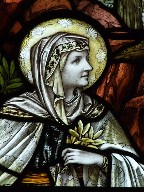 |
|
I first came here on a
glorious spring day, the Saturday of Easter
week 2003. I was cycling through the
narrow, lost lanes of north Suffolk
between Redgrave and Hepworth. This
is a distance of some five miles, but I
didn't see a single car, or even another
human being, apart from a man walking a
huge dog in the fields by Hinderclay. The lanes forked
and joined meaninglessly; or, at least,
without meaning for the 21st century. In
years gone by, they must have connected
long-forgotten hamlets, and separated
strips of now-enclosed land. What we see
today is merely an echo of what George
Ewart Evans called the pattern under the
plough. All around me, across the
fields and on the horizon, were churches.
Some had bold, square towers rising above
the trees; others were gleaming flint
shells, huddled in distant hedgerows.
Some were old friends that I recognised
and greeted: Hinderclay, Thelnetham, Market Weston and Hopton. Others were
across the Norfolk border, mysterious and
remote. Once, I heard a clock striking
midday across the green barley. I
resisted their enticements, and forged
on. But I was filled with a sense of
continuity. In these burgeoning spring
fields, there was still beating a heart
of old; the unforgotten rhythm of
Christianity, as it was when these were
built as Catholic churches, and as it is
now in the care of gentle Anglican faith
communities. The churches seemed to pin
the land down, stabilising and guarding
it, embracing and healing the lives led
around them. It was a reassuring image in
Easter week.
|
St Peter sits in a
tight, raised churchyard on the edge of the
village. Its appearance is a little curious, and
there are a couple of good reasons for this. The
tower was shortened because it was unstable in
1677 - you can see the date on the western side.
The metal banding is an early 19th century
attempt to stop it collapsing completely. But the
event that really shaped the current St Peter
happened in 1898 - Sam
Mortlock
tells us it was on Easter Monday. On that day,
the thatched church as it was then was almost
completely destroyed by fire. J.S. Corder of
Ipswich was chosen for the rebuilding; his is the
extraordinary Gothick tower at Swilland, but here he was
conventional, probably because he knew that the
Society for the Protection of Ancient Buildings
were looking over his shoulder. Except, perhaps,
for the most curious feature of St Peter. It is
right at the top of the stubby tower. Up here,
there is a little pyramid, as at Bromeswell. But this one has a
delightful dormer window in it, facing west. You
can only see it from the road, the parapet hides
it close up. I fantasized that there might be a
little room up there, with someone living in it.
Corder liked dormer windows in towers, and the
one at Swilland is exotic, to say the
least.
On the occasion of
my first visit I was disappointed to find
Hepworth church locked without a keyholder
notice, but times have changed, and today there
are three friendly keyholders who are not only
happy but enthusiastic for you to see inside. You
step into a pleasant late Victorian nave, and how
could it be anything else, given the
circumstances. But the church is not without its
medieval survivals, and the best of them is the
most intriguing font cover in Suffolk. It dates
from the 15th Century, and appears to have
originally been telescopic, although it was
altered later to have opening doors. It is
reminscent of the one at Ufford, though not as tall, and
the paint was removed in the 18th century, but it
is remarkable in that so many of the figures have
survived (the ones at Ufford at 19th and 20th
century replacements). There are two ranges - the
upper range consists of niches, and the figures
have gone. But the lower range consists of a
landscape of castles and battlements - you see
the backs of small, naked people going in through
small doorways, and emerging as knights from
larger doorways, sword in hand, to do battle with
the world, the flesh and the devil. I guess it is
meant to represent the power of baptism. There is
a 19th century cross clumsily added to the
pinnacle. It survived the fire, which I couldn't
help thinking would look rather suspicious to the
insurance company if it happened today. The font
it sits on is late Victorian.
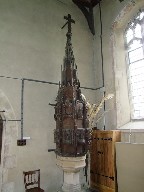 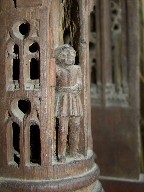
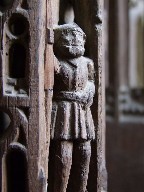
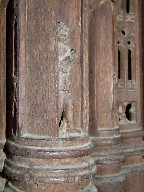
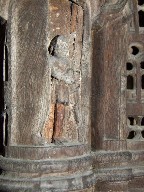
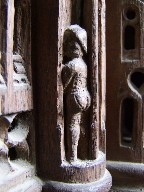
Everything is
spick and span. The nave is neatly benched, and
there is a decent turn of the 21st Century window
by Bronwen Gordon depicting four scenes,
including the manna in the desert and its New
Testament echo, those who hope in the Lord.
Nearby are several memorials to the Methwold
family of Hepworth Hall, one a beautiful yet sad
Art Nouveau brass to two children, John
Robert Tindall, beloved infant son of Henry
Tindal Methwold and Sybil Mary his wife... and of
their darling child Margaret Consuelo... Both
children died under the age of two, three years
apart. The pulpit was apparently the 1920s work
of Sir Henry Methwold.
| Another
Methwold memorial in the chancel is a
good example of the late Victorian and
Edwardian enthusiasm for depicting real
people in Biblical scenes. It is a window
by Powell & Sons which shows the two
Marys meeting the angel at the empty
tomb, but the Virgin Mary is represented
by the figure of Mary Ellen Methwold, who
died in 1902. The scallop shells on her
head dress appear on the other Methwold
memorials. In general, the chancel is a
fine example of early 20th century High
Church solemnity, still retaining Art
Nouveau cross and candlesticks and a
choice red carpet. A brass memorial to
Anthony Radice, Rector here for 25 years
through the sixties and seventies, is a
simple, Latin reminder of quite how High
Church Hepworth must once have been.
There is a sweetly arched low-side window
not unlike the one at Stanningfield, but this one is
neatly glazed. Back in the nave, a curious
feature is the set of handbells suspended
on a rod across the tower arch. They were
given to the Parish in the 1920s, but
unfortunately they are no longer in use.
Simon Jenkins observed that the parish
churches of England are the largest folk
museum in the world, and Hepworth church
feels at once the heart of a living faith
community and a touchstone to the life of
its past, and who could ask for more from
a parish church?
|
|
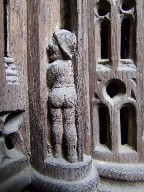 |
|
|
|

